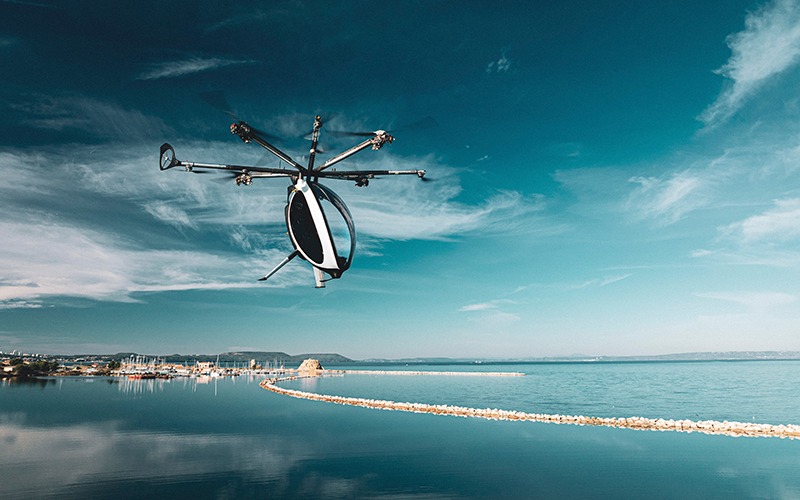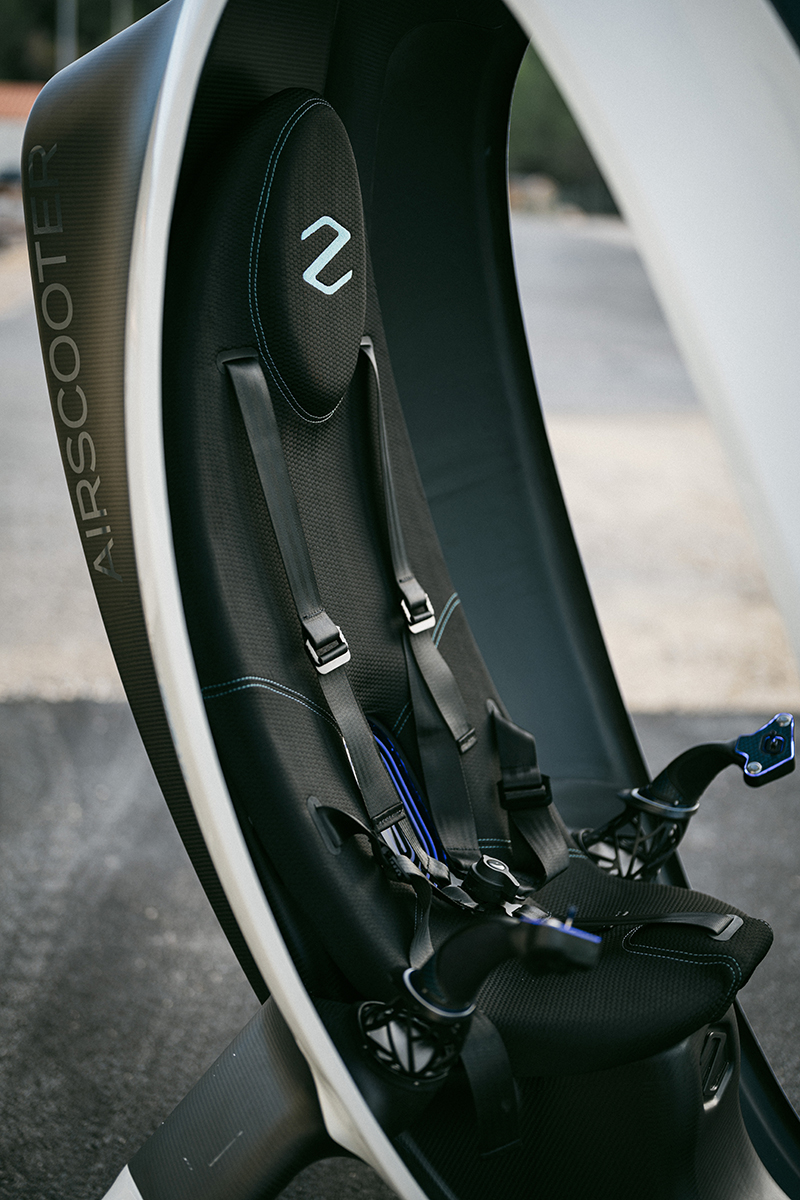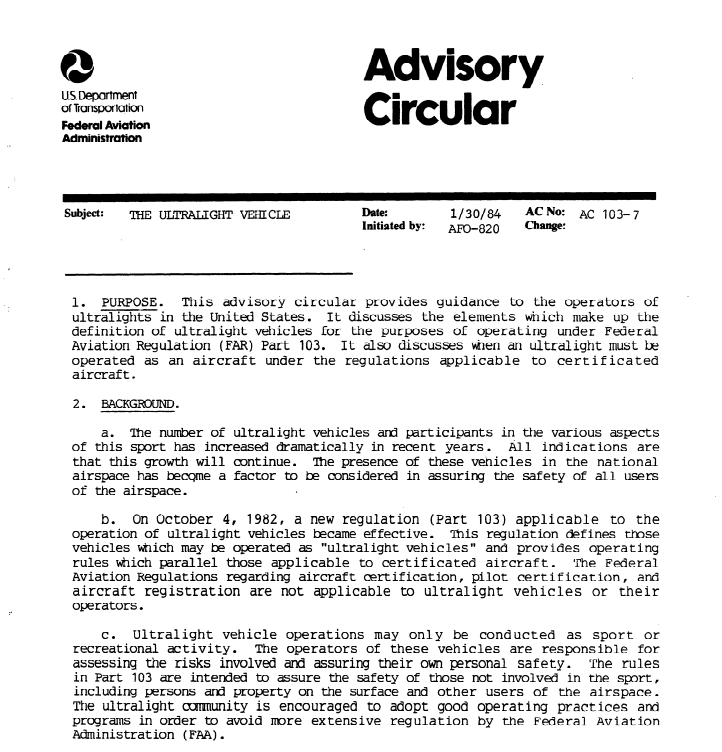
What is an ultralight aircraft?
Defining Ultralight VEHICLES
Ultralight vehicles, often referred to as microlights in some regions, are a category of small, lightweight aircraft designed for simple and efficient flying. They are known for their minimalist design and are typically limited in terms of weight, speed, and passenger capacity. The exact definition may vary from country to country, but the key characteristics include:
1. Weight Limit: Ultralights must adhere to strict weight limits (254 pounds or 115 kilograms empty weight in the United States).
2. Speed Limit: Ultralights are generally limited to a maximum air speed (55 knots, 63 mph or 102 km/h in the United States).
3. Passenger Capacity: In the spirit of recreational flying, most ultralights are single-seater vehicles.
Federal Aviation Regulation “Part 103” prescribes rules governing the operation of ultralight vehicles in the United States. Actually, in the USA, Ultralights are not considered as “aircraft” and therefore don’t follow the same rules as certified aircraft.
Types of Ultralight VEHICLES
Ultralights come in various forms to cater to different preferences and purposes. Here are some of the most common types:
1. Fixed-Wing Ultralights: These resemble traditional airplanes but with simplified controls and often an open cockpit. They are known for their stability and ease of handling.
2. Flex-Wing Ultralights (Trikes): These consist of a delta wing and a motorized tricycle-like undercarriage. Trikes offer a unique and exhilarating flying experience.
3. Powered Paragliders (PPG): Powered paragliders are lightweight engines strapped to a paragliding wing. Pilots wear a backpack-like motor and run into the wind to take off.
4. Gyrocopters: Gyrocopters have a rotor similar to a helicopter but rely on an unpowered overhead rotor and a conventional engine for propulsion.
5. Multicopters / VTOL : a multicopter is an aerial vehicle whose motion is controlled by speeding or slowing multiple downward thrusting motor/propeller units.
Why Choose Ultralight aviation?
Ultralights have gained popularity for several compelling reasons:
- Affordability: Compared to traditional aircraft, ultralights are relatively inexpensive to purchase and maintain, making flying more accessible to aviation enthusiasts.
- Simplicity: Ultralights are designed to be easy to operate and maintain, making them an attractive option for those new to aviation.
- Thrilling Experience: Flying in an ultralight vehicle offers a unique sense of freedom and exhilaration, with the wind in your hair and an unobstructed view of the landscape below.
- Accessibility: Many ultralight vehicles can be stored at small private airstrips or even in a garage, eliminating the need for a large hangar or airport facilities.
Ultralight Aircraft – Regulations
While ultralights offer numerous advantages, they are not without regulations. It’s crucial for pilots and enthusiasts to understand and comply with these rules to ensure safe and responsible flying. Some key regulations include:
1. Licensing: in the US, operators of ultralight vehicles are not required to meet any aeronautical knowledge, age, or experience requirements. On the other hand, in some countries, pilots require training and licensing to operate an ultralight aircraft.
2. Weight Limits: Ultralights must adhere to strict weight restrictions, and exceeding these limits can result in legal consequences.
3. Operational Limits: Ultralights are often restricted in terms of where and when they can fly. Certain airspace and weather conditions may limit their operations.
4. Maintenance: Regular maintenance and safety checks are essential to keep an ultralight aircraft in safe flying condition.
Safety Considerations
Safety is paramount in aviation, and ultralight flying is no exception. Here are some safety considerations for ultralight pilots and enthusiasts:
1. Training: Proper training is crucial for safe ultralight flying. Seek out professional flight centers and instructors to learn the necessary skills and safety procedures.
2. Weather Awareness: Ultralights are sensitive to weather conditions. Pilots should be mindful about weather forecasts and avoiding adverse conditions.
3. Pre-flight Inspections: Always conduct thorough pre-flight inspections to ensure the aircraft is in optimal condition for safe operation.

The Future of Ultralight Aircraft
As technology continues to advance, the world of ultralight aircraft is not standing still. Innovations in materials, engines, and avionics are opening new possibilities for ultralight design and performance. Hybrid Electric propulsion, for example, paired with Sustainable Aviation Fuel, is becoming a reality, offering safe, affordable, quiet, and more environmentally friendly flying experiences.
In the realm of aviation, ultralight aircraft (or ultralight vehicles) occupy a unique and thrilling niche. With their affordability, simplicity, and accessibility, they provide an opportunity for individuals to experience the joy of flight in a way that was once reserved for only a select few. Whether you’re a seasoned ultralight pilot or someone considering taking to the skies for the first time, understanding what ultralights are and the principles that govern them is essential for a successful and rewarding flying experience.
So, spread your wings, and let the adventure begin!

